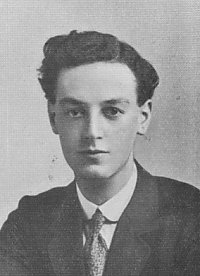
CYRIL HENRY GILLHAM
The branch of the Gillham family to which Cyril Henry belonged had been resident in Portsmouth since before the first census in 1841 which featured his great-grandparents Arthur and Elizabeth and their seven children, the third of whom was Henry William, Cyril's grandfather who was born in 1828. The family were then living on Ivy Street, Portsea.
Henry William married Ruth Clark in 1855. She had been born in Coventry in the same year as her husband. The 1861 census shows the couple living at 4 Frederick Street with the first two of their children Mary and Elizabeth. Ten years later they were recorded at 32 Brunswick Road with three more children - Emily, William Henry and Ellen. Henry William was listed as a schoolmaster.
The third born, William Henry was destined to become Cyril Henry's father but in 1881 at the age of 16 he was recored in the household of his aunt Jane Clark at 66 Prince George Street; he had already begun work as a printer and compositor which would become his trade up to and beyond the Great War. In 1896 he married Alice Mary Sewell who had been born in London in 1869 and they set up home at 43 Powerscourt Road and later at 284 Laburnum Grove. They had just two children, Cyril Henry and Ronald William, born in 1898 and 1902 respectively.

Cyril Henry began attendance at the Secondary School on Victoria Road North in 1909 and stayed there until 1913 when he obtained a high place in the Dockyard Entrance Examination, entering the Dockyard as an Apprentice in the Electrical Department.
As soon as he reached the age of 18 he attested under Lord Derby's Scheme, but was not released from his indentures until June 1918, when he was called up to join the 2/4th Battalion Hants Regiment. Then followed three months of strenuous training, and on the 7th October, 1918, he sailed for France.
The fighting about this time was very heavy. The enemy was contesting every inch of ground. Only five days before the Armistice, on 6th November, 1918, the Platoon to which Cyril Henry belonged, in its eagerness to keep in touch with the retreating enemy, had become detached from the main body of the Battalion, and the subaltern in command wished to re-establish communication with his Commanding Officer whom he thought to be just on his left. Gillham and a friend, known to be trustworthy runners, were asked to volunteer for the task of delivering the Platoon Officer's message. Gillham accepted, and set out, never to return.
Exactly what happened will never be known. The burial party following the Battalion found no trace of his body. But on November 9th, near Mons, a R.F.A. gunner found the body of a British soldier shot through the neck. In his hand was his rifle and in his pockets were certain papers and letters belonging to C. H. Gillham. He must, therefore, have gone nearly 20 miles in search of his Battalion, for he started in the neighbourhood of Maubeuge.
His Commanding Officer wrote of him — " During the short time he was with me he proved himself an honest and brave soldier. He died carrying out his last orders."
Further Information
The photograph above is taken from a memorial booklet published by Southern Grammar School from which extracts also appear above.
The Commonwealth War Graves Commission (CWGC) website lists Private Cyril Henry Gillham (55404), 2nd/4th Battalion, Hampshire Regiment, date of death, 06/11/1918, aged 20. He is buried at Maubeuge-Centre Cemetery, Grave Ref: C.15. Son of William Henry and Alice Mary Gillham, of 95, Ophir Rd., Portsmouth.
Cyril Gillham's name appears on the Southern Grammar School WW1 Memorial, the Buckland United Reformed Church WW1 Memorial and the Cenotaph. He is not listed in the National Roll of the Great War.
Tim Backhouse
July 2014